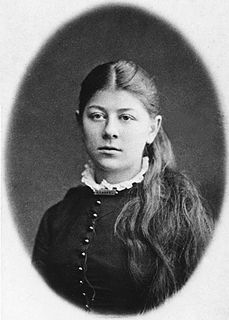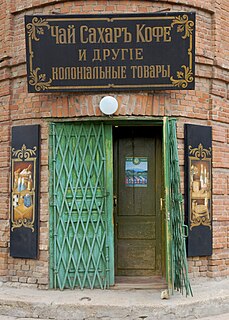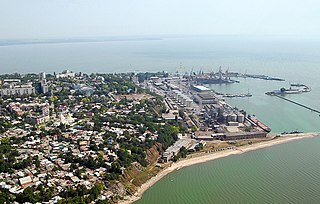
The southern Russian city of Taganrog began as one of Russia's first planned cities under Peter the Great. To protect the newly conquered Sea of Azov region, the Russians opened a naval base there in 1698 and a city and seaport were built. However, after the Turkish victory in the war of 1710–1711, Taganrog city and port were demolished prior to handover to the Turks.

The Peter I Monument in Taganrog is a monument to Peter I of Russia in Taganrog.

The Taganrog Drama Theater named after Anton Chekhov and decorated with Order of Honor is a traditional Russian drama theater based in Taganrog, Rostov Oblast.
Yevgeny Mikhailovich Garshin was a Russian teacher, novelist, publisher, director of the Commercial College in Taganrog (1901), younger brother of the Russian writer Vsevolod Garshin.

The Chekhov Gymnasium in Taganrog on Ulitsa Oktyabrskaya 9 is the oldest gymnasium in the South of Russia. Playwright and short-story writer Anton Chekhov spent 11 years in the school, which was later named after him and transformed into a literary museum. Visitors can see Anton's desk and his classroom, the assembly hall and even the punishment cell which he sometimes visited.

The Birth house of Anton Chekhov is the place in Taganrog, Russia, where the famous writer Anton Chekhov was born. It is now a writer's house museum. The outbuilding on the territory of a property on Chekhov Street in Taganrog was built in 1859 of wattle and daub, plastered and whitened. The area taken up by the small outbuilding is 30.5 sq. meters. The house and grounds were owned by the merchant Gnutov in 1860, and by the petit bourgeois Kovalenko in 1880-1915.

Chekhov Library in Taganrog is the oldest library in the South of Russia.

Taganrog Museum of Art was officially inaugurated in 1968, but the basis of the museum collection was formed by the end of the 19th century, when the art department of the Taganrog's city museum was established.

The monument to Alexander I of Russia was erected on the initiative of the people of Taganrog in memory of the emperor's stay and death in the city.

The Gorky Park is a municipal park of culture and recreation in the city of Taganrog, Russia.

Maria Pavlovna Chekhova was a Russian teacher, artist, founder of the Chekhov Memorial House museum in Yalta, and a recipient of the Order of the Red Banner of Labour. Anton Chekhov was her brother.

The Chekhov Shop is a museum in Taganrog, Russia. This is a two-storey house where the famous Russian writer Anton Chekhov stayed with his family from 1869 to 1874.
The Pushkin Embankment or Pushkin Quay is a street along the Gulf of Taganrog in downtown Taganrog,a seaport city in Rostov Oblast, Russia.

The A.P. Chekhov Literary Museum is a museum in Taganrog, Rostov Oblast, Russia. It is situated in the building of the former men's classical gymnasium, where Anton Chekhov studied. It is part of Taganrog State literary and historical-architectural museum-national park.

The Chekhov Monument in Rostov-on-Don, Russia is a bronze monument erected in 2010 to commemorate the 150th anniversary since birthday of the Russian writer Anton Pavlovich Chekhov. The monument is located at the intersection of Chekhov street and Pushkinskaya Street.

The Man in a Case is a sculptural composition in Taganrog, created by sculptor David Begalov based on the story of the same name by Anton Chekhov.

Taganrog State Literary and Historical and Architectural Museum-Reserve is an association on the basis of literary and local history museums.

Red Square is a city square of Taganrog.



























